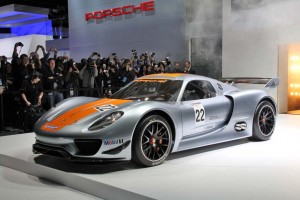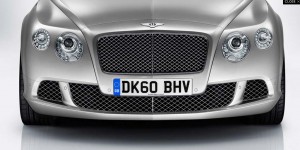“There’s no replacement for displacement,” goes the old automotive adage, and nowhere has that approach carried more weight than in the luxury market, where big V8s and V12s are the norm, rather than the exception.
At least until now. But with U.S. regulators looking at a 62 mpg CAFE standard and even tougher restrictions likely to go into effect in Europe, luxury makers like Porsche, Mercedes-Benz and Bentley are looking to downsize their powertrain line-up.
The trend is already apparent in the mainstream of luxury models, where four-cylinder gas and small turbocharged diesels have become as much the norm as the exception. But the shift is beginning to take hold in even the most performance-oriented models, such as those produced by Ferrari, Bentley and Mercedes’ AMG division.
Bentley officials will soon have to decide whether to authorize a new, third line of performance cars, as TheDetroitBureau.com earlier reported. (For more, Click Here.) An inside source now tells TheDetroitBureau that this line-up would use V8s, rather than the traditional Bentley V12, and possibly even a smaller powertrain.
If the trend requires smaller, or even alternative powertrains, hinted Dr. Franz-Josef Paefgen, Bentley’s outgoing CEO, “We will not only follow but lead the way. If the law is 62 mpg, we’ll still deliver the strongest 62 mpg engine on the market.”
How precisely to get there is something performance luxury makers are currently struggling with. New Porsche CEO Wolfgang Durheimer made no secret of his company’s efforts to deliver serious numbers out of a long-rumored 4-cylinder engine. It could even wind up in the brand’s vaunted flagship, the 911, as well as the smaller Cayman and Boxster models – though Porsche’s well-proven flat six won’t be going anytime soon, according to Durheimer.
Meanwhile, AMG, the Benz brand-within-a-brand, is working on hybrid alternatives, according to Daimler AG’s director of advanced engineering, Herbert Kohler. “In the future,” he told Britain’s AutoCar magazine, “there will be hybrids.”
Indeed, AMG is already blazing an alternative path, having unveiled the production version of the new Mercedes-Benz SLS AMG E-Cell at the Detroit Auto Show. Plans call for the maker to produce several hundred of the battery-powered supercars, Daimler CEO Dieter Zetsche told TheDetroitBureau.com, the price tag expects to run somewhere between $300,000 and $400,000. (For more on the E-Cell, Click Here.)
Luxury makers have been looking at all manner of alternatives, and diesel, flex-fuel, hybrid and even hydrogen powered-models already have shown up with BMW, Bentley, Mercedes and Lexus badges. Wringing out enough power to fit into the true performance or supercar class is another matter.
Like Mercedes, Audi is toying with battery propulsion, and has so far displayed two eTron concepts. The original coupe, like the SLS E-Cell, delivers supercar performance from a pure battery-electric powertrain. The later eTron convertible, which bears a strong similarity to Audi’s R8 roadster, goes the plug-in hybrid route. The battery system can be used around town in less aggressive driving – or kick in to give an added boost to the gasoline part of the driveline when a motorist puts pedal to the metal.
Electrification is the big buzzword in the auto industry, these days, and even Ferrari is looking to integrate a Formula One-derived hybrid system into its production cars.
Then there’s Lotus, which said it would use a track-based gas-electric drive system on most of its future models – five of which it revealed during the Paris Motor Show, last September.
Porsche is also geared up to go hybrid. The 918 RSR race car, which debuted at this year’s Detroit Auto Show, uses a unique flywheel system to deliver maximum muscle the moment the driver flicks a switch on the steering wheel. (For more, Click Here.)
The system is not designed for street driving, however, so Porsche also is developing more conventional battery-based hybrid systems. The first debuted on the big Cayenne SUV and will migrate to the 4-door Panamera – and eventually to other models, such as the Boxster and perhaps the 911.
Even the conventionally-powered Panamera features Stop/Start technology, a system that automatically shuts off the engine when it might otherwise waste gas idling, such as at a stoplight. When the driver’s foot lifts off the brake the engine automatically restarts.
Stop/Start systems are expected to become more the norm than the exception over the next decade, and with estimated fuel savings of as much as 10%, they could prove particularly popular on top-line performance models that need every advantage to boost fuel economy.
Whether 62 mpg becomes the law of the land remains to be seen but the oddsmakers are betting that some significant increase in mileage will be put in place for the 2025 timeframe. Getting there will be a challenge for even the most mainstream of automakers, and even more so for performance brands. So expect to see displacement give way to technology in the years ahead.


